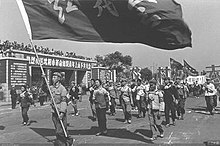
Back Moviment Baixar al camp Catalan Movado Alkamparena Esperanto Alas maaseudulle -kampanja Finnish Mouvement d'envoi des zhiqing à la campagne French Gerakan Turun ke Pedesaan ID 上山下郷運動 Japanese 상산하향 Korean Gerakan Turun Desa Malay Ut på landet-bevegelsen NB ਸ਼ਹਿਰਾਂ ਤੋਂ ਪਿੰਡਾਂ ਵੱਲ ਨੂੰ ਮੁਹਿੰਮ Punjabi
| Down to the Countryside Movement | |||||||||||||||
|---|---|---|---|---|---|---|---|---|---|---|---|---|---|---|---|
 Some of the 200,000 sent-down youth from Shenyang (1968) | |||||||||||||||
| Traditional Chinese | 上山下鄉運動 | ||||||||||||||
| Simplified Chinese | 上山下乡运动 | ||||||||||||||
| Literal meaning | The Up to the Mountains & Down to the Villages Movement | ||||||||||||||
| |||||||||||||||
| Resettlement | |||||||||||||||
| Traditional Chinese | 插隊落戶 | ||||||||||||||
| Simplified Chinese | 插队落户 | ||||||||||||||
| Literal meaning | join the team, leave the home | ||||||||||||||
| |||||||||||||||
The Up to the Mountains and Down to the Countryside Movement, often known simply as the Down to the Countryside Movement, was a policy instituted in the People's Republic of China between the mid-1950s and 1978. As a result of what he perceived to be pro-bourgeois thinking prevalent during the Cultural Revolution, Chairman Mao Zedong declared certain privileged urban youth would be sent to mountainous areas or farming villages to learn from the workers and farmers there. In total, approximately 17 million youth were sent to rural areas as a result of the movement.[1] Usually only the oldest child had to go, but younger siblings could volunteer to go instead.
Chairman Mao's policy differed from Chinese President Liu Shaoqi's early 1960s sending-down policy in its political context. President Liu Shaoqi instituted the first sending-down policy to redistribute excess urban population following the Great Chinese Famine and the Great Leap Forward. Mao's stated aim for the policy was to ensure that urban students could "develop their talents to the full" through education amongst the rural population.[2]
Many fresh high school graduates, who became known as the so-called sent-down youth (also known in China as "educated youth" and abroad as "rusticated youth"), were forced out of the cities and effectively exiled to remote areas of China. Some commentators consider these people, many of whom lost the opportunity to attend university, "China's Lost Generation". Famous authors who have written about their experiences during the movement include Nobel Laureate Liu Xiaobo, Jiang Rong, Ma Bo and Zhang Chengzhi, all of whom went to Inner Mongolia. Dai Sijie's Balzac and the Little Chinese Seamstress has received great praise for its take on life for the young people sent to rural villages of China during the movement (see scar literature). General Secretary of the Chinese Communist Party Xi Jinping was also among the youth sent to rural areas. Xi was a send-down youth for seven years until he enrolled in Tsinghua University's chemical engineer program in 1975.[citation needed]
In 1978, the government ended the movement, but the sent-down youth were not allowed to return to their homes in urban areas, with exception of those who enrolled the university through Gaokao and some whose parents or relatives were high-level officials. After a huge wave of protest across the country by the send-down youth especially in Xishuangbanna, the State Council eventually allowed the send-down youths to return to urban areas in early 1979.[citation needed]
Resettlement in the countryside (chāduì luòhù) was a more permanent form.[3][4]
- ^ Ebrey 2005, p. 194
- ^ Dietrich 1997, p. 199
- ^ McLaren, Anne (1979). "The Educated Youth Return: The Poster Campaign in Shanghai from November 1978 to March 1979". The Australian Journal of Chinese Affairs. 2 (2): 1–20. doi:10.2307/2158728. ISSN 0156-7365. JSTOR 2158728.
- ^ Thornber 2012, p. 147